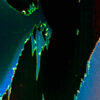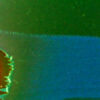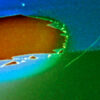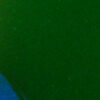1
One day I see a wild deer. It is evening, the second month of lockdown in the first spring of the pandemic. I am outside with my pregnant dog, who is days away from delivery, her first, but it doesn’t look like she is pregnant at all. Her stomach is almost concave and aside from a week when she was ravenous, her appetite is delicate and her mood strange. The vets in this Oxfordshire village where we have decamped to ride out what we imagine will be the first and only wave of this virus won’t give us an appointment. It’s not an emergency, they tell me on the phone, we are only seeing emergencies during Covid. No one knows what Covid is yet, none of us know how to behave. What does the virus have to do with a pregnant dog? I describe my dog’s hollow stomach, the stillness when I place my hand on her belly. Once, I thought I saw something move. Another time, I thought I saw something poke out of her flank in a picture. It’s not a phantom pregnancy, she’s had one of those before. We had a scan, she is carrying a litter of puppies.
But something doesn’t feel right. She sounds fine, these new vets – who we don’t know and have never met – tell me on the phone. We are not from here; we are far, far away from home.
Outside, in the garden, Coco and I both see the deer. It seems large for a deer, tall and noble, her skin reddish in the twilight. My dog is small, six kilos with the weight of her non-phantom babies. Coco descends from hunters and ratters and dives into rabbit warrens, runs up trees, she burrows and digs and pirouettes, and though she is the gentlest creature I have ever known, thrilled by the chase but never by the kill, she took a rabbit by the throat the other day. MC, who is a garden designer, was thrilled. She leads dendrology tours all over the world, examining the flora and fauna of Chile, Yemen, Greece. When she’s home, she tends to her heritage garden in Oxfordshire, growing deep purple irises, plump red roses, perfumed magnolia trees. Allegra – my best friend – and I have rented a small part of MC’s cottage, and in the evenings of our lockdown, MC walks us through the sprawling garden to smell the perfume of the night-blooming flowers.
The rabbits eat all her rare and precious plants and we were together when Coco proudly wagged her curly tail over her dead prey, running back and forth between me and the grey rabbit’s warm, twitching body, eager for praise. ‘Well done, Coco,’ MC cooed. I didn’t praise her, but I understood. She was hunting for her babies, hunting to be sure there would be food for her young. Now, Coco glares at the wild deer, her spine arched, the hair on her neck standing on end, her lithe, balletic body trembling, ready to catch and kill the doe too.
Barry Lopez, who wrote about wild wolves in his seminal book Of Wolves and Men, describes the moment a hunter and its prey lock eyes. A decision is made then, Lopez says, in this moment he calls ‘the conversation of death’. There is ritual in the exchange between hunter and hunted: ‘the flesh of the hunted in exchange for respect for its spirit’. This tension doesn’t exist in captive animals; it’s bred out of them. But free animals, wild animals, obey a sacred order. One animal must kill to live, to feed the old and the young of its pack, and the other must surrender himself to protect his brethren, his old and young, from being taken. There is, Lopez writes in his ethnography of wolves, a dignity in this encounter – both animals, not just the predator, make a choice in this ceremony. They agree on death. ‘When the wolf “asks” for the life of another animal he is responding to something in that animal that says, “My life is strong. It is worth asking for.”’ The nobility of this death is that it is appropriate, it is a chosen death. Not a tragedy. ‘I have lived a full life, says the prey. I am ready to die. I am willing to die because clearly I will be dying so that the others in this small herd will go on living.’
My life is strong. It is worth asking for.
Chosen death. I think of my father, Murtaza. He was a politician and an MP in Pakistan. He was forty-two years old when he was killed, only four years older than I am now, but he made the decision to give his life long before that, when he was a young man, just after his own father was assassinated. My father raised me on his own, as a single father, till I was eight years old. He made our life, lived in exile during the dark days of Pakistan’s dictatorship in the 1980s, a game of fun and mystery. But there would come a time, he always told me, preparing me, that they would take him too. When I cried and begged him to take his warnings back, my father would hold me and kiss me and wipe away my tears. I had to be brave, he would tell me, always smiling, it was my patrimony. He never took his warnings back. Though he loved his time on Earth, he knew that when they came to take it, he would give them his life. There was a beauty to my father, a romance to how he saw the world, no matter its cruelties. I think it came from that acceptance, what Nietzsche called amor fati, a love of one’s fate. It is a radical choice not to ‘merely bear what is necessary’, Nietzsche wrote, ‘but love it’. The brave meet death with courage, there is no other choice. But free men meet it with joy.
From my understanding of the philosopher – and who really understands Nietzsche? – this is what makes ordinary humans great: a total love and acceptance of their fate. At the time he was killed, my father was in the prime of his life, the father of a young son and teenage daughter. He had just begun his career in politics, there was promise in his future. He had so much to do and much to struggle against. But he would not have traded that giving of his life, his strong, hopeful life, for anything – not for power, not for wealth, not even for me. It was a gift, he wanted to give it. ‘I should like to be able to love my country and still love justice,’ Albert Camus said. My father loved both.
We know almost nothing about animals. What little we know, we can only see through a prism that reflects our own image. Ours is the purest image we know; we are thoughtlessly entranced by it. To us, there is nothing on Earth greater or grander or more sophisticated than the self, than ourselves. This is our great failure as a species. We use all our strengths, intelligence and time in pursuit of a very shallow idea – that we are special. This is an ancient idea, constantly at war with that essential truth spoken thousands of years ago by Buddha: there is no self. We are not unique and no essence of ours will remain. Ultimately, we, like everything else on Earth, are pure matter, dust. It is how we are born and how we will end, absorbed into the earth and forgotten.
Coco is no wolf, no saviour, no prince among men. She is a Jack Russell terrier, the size and hysteria of a mongoose, at best. She has no chance against a deer, a centaur compared to her tiny frame. But she doesn’t know that. She is lit by a primal confidence, a natural stalker enlivened by the scent of a beautiful adversary. MC, the garden designer, tells me later that the deer, who also devour her plants, are muntjacs, and that they have come to Oxfordshire from China, introduced in the early twentieth century. But escapes and releases of muntjacs into the wild have resulted in feral populations running loose across England.
Coco holds the deer’s gaze for five seconds and then, conversation exchanged, leaps at it, heart pounding, racing, running to be joined in ceremony. But the deer escapes. It doesn’t jump over the garden fence, it doesn’t hit the brick and mortar of the home, it just disappears, vanishes. We never see it again.
2
Coco has been with me since she was three months old. I bought her as a gift for my youngest brother and then, in the two nights that it took to vaccinate her and fly her home to Pakistan, fell in love with her. He had asked for a girl dog, named her after a Japanese cartoon character, even decided where she would sleep – with him, at the foot of his bed. By the time we reached Karachi, I was already thinking how best to break the bad news to a ten-year-old boy. But immediately after meeting my little brother, Coco growled at him, snarling, showing off her sharp little teeth. ‘The good news is I bought a dog,’ I told him warmly. ‘The bad news is that she’s mine.’
I felt no guilt over it; by day three, Coco was bonded to me and I to her. It turned out for the best. As a matter of principle, Coco hates children. She isn’t fond of other people or dogs either. As a pup she barked at strangers on the road, incensed that others might walk on the very street she was using. When she doesn’t like someone (this is often), she has been known to yap tirelessly at them until they go away. She is exceedingly bright and loving to a select few, but putting it mildly, she is a character. To me, she is perfect, and over our years together, has been faithful, constantly watching over me.
Though I have had dogs all my life, Coco is my first real companion. I cared for her and she for me at a point when I was figuring out how to live, how to remake a world of my own, alone. In those lonely years, Coco and I travelled continents together and set up quiet lives. As anxious as I was, as uncertain of how to build a small corner for myself, I somehow managed to care for this dog and she not only survived, she grew, she learned, she adapted and even thrived. A model writer’s dog, she sits quietly while I work, holding a ball in between her paws, her body tensed but patient for hours. Always cautious, Coco turns to look at me in the park when she spots a pigeon – shall we chase him? – awaiting approval and confirmation that this is something I’d like her to do on our behalf. The times I have gotten angry at Coco are when she has behaved like an animal, running across traffic in chase of a cat without checking with me first, overturning the garbage, jumping on the kitchen table to eat all the food or kicking off her nappy when she’s on heat to smear blood all over the floor in decorative trails. I get angry because I know I cannot protect her in her world, the animal world, but only in mine.
At night, my dog burrows under the covers of my bed. Only once she has rooted and rustled, sleeping for a while in the den-like dark under the blankets, does she slowly drift up until she is on the pillow and we are nose to nose. When I hold her and stroke her, telling her how clever she is, how pretty, how good, she closes her eyes and sighs, breathing softly. When I am working and her store of patience has finally run out, she jumps up to my lap and rests her warm throat in the crook of my elbow so I cannot write or type. We have been through scares, heartbreaks, stayed in hotel rooms in strange cities, boarded planes and boats and trains, learned tricks, lost people, been betrayed. There has been so much life in this little time. Only six years.
I wanted her to have a litter of puppies because it was essential for her health and general life experience. It wasn’t because I wanted children, was desperate for my own, and could do nothing about it. It would be good for her, becoming a mother, good for me too, good for us, I said. It would be good for us.
Forty kilometres from Kathmandu is Namo Buddha. The road there is choppy, bumpy, choked with the smog of scooters and trucks and jeeps, some with stickers of Prince Siddhartha, cross-legged and serene, plastered on their rear windows. It is there, at the Namo Buddha stupa, that Buddha encountered a starving tigress and fed her of his own flesh.
The tigress, her body hollowed and drooping, was close to death. Already her cubs had no food; when she died, they would too. Overcome with compassion, Buddha gives himself to her, feeding the tigress his body so that she may eat and her cubs survive. I travelled to Namo Buddha some years ago, alone, with a guide. The tigers have all gone now, there are barely any left in the Nepalese wild, just over 200. I went to the stupa, a dusty mound, away from the oxblood walls of the Thrangu Tashi Yangtse Monastery where young boys with shaved heads chant prayers. There was no one there, save an old lady selling amulets on a rickety table.
It was on that journey to Nepal that I first became enchanted with the wild. In Chitwan, days earlier, we had tracked the vanished tigers – seen their claw marks on the bark of aged trees, smelled their scent – but never seen them. We trekked into the jungle at dawn, at dusk, on foot, in cars. I went birdwatching, and bathed a wounded elephant. I had never been so close to the living world before, never so transfixed. I was lonely; being close to the wild comforted me, soothed me. Ecclesiastes tells us that ‘dark is the wilderness’, the wild a place no one can see God. But God is everywhere in the wilderness. If God is not there, in the mist that travels through a forest at dawn, in the dew that nourishes the soil, in the delicate birds and scavengers, then where is God?
It was in a deer park that Buddha gave his first sermon. And there, among the monks as Buddha expounded the four noble truths, ‘I teach suffering – its origin, cessation and path. That is all I teach,’ was a doe, listening.
3
Coco’s due date came and went. She had mated twice but counting from the second time, she was still late. Her stomach never grew though she became sluggish and her energy sunk to nothing. Dogs, like humans, have morning sickness, throwing up yellow bile and suffering fluctuations in appetite. I clung to the fact that Coco had experienced both these things. A phone call to a vet in London raised my alarms, she should absolutely be checked they insisted. The Oxfordshire vets begrudgingly consented and so, in masks and gloves, I brought Coco for a check-up.
No humans were allowed into the clinic, Covid protocols were still new and strange and Coco was taken from the car kicking and screaming. She returned twenty minutes later, leaping, desperate to escape the vet, who told me from a distance that yes, she was fine, he saw the pups. Two of them, heads and spines growing nicely. It should be any day now. When I told friends who knew something of the world of dogs, they went quiet. Only two puppies? they asked. Are you sure? I had always felt something wasn’t right. But I had read the books and prepared the whelping box and bought the vet-bed fleece and had forceps and scales, calcium and glucose, everything that I could possibly need. I wrote out a list of warning signs for the two friends I was with in case the delivery happened while I was out running.
Allegra, an Italian writer, and I have been best friends for over fifteen years now. I was staying with her when I bought Coco. Allegra, I texted her, having forgotten to mention I was getting a dog, would it be OK if I brought a dog home? Just for two nights? Allegra’s home is beautiful, furnished with exquisite taste, not a cushion out of place. Ever generous, Allegra consented, sounding only a little worried. When she came home that evening and saw a little pup dancing on her antique carpet, she smiled and asked me to make sure I washed her feet and my hands every time we returned from the outside. She liked Coco but didn’t particularly want her on her bed or sitting on the chairs around the dining table. Allegra’s caution lasted about a day. Today, they go walking for hours in the park. Allegra mushes up dog food with her fingers and sings Coco good-morning songs and buys her treats, hiding them in her room so when they are curled up together, on the bed where Coco sprawls luxuriantly, paws unwashed, Allegra can feed her one, two or three, as she whispers praise while stroking the patterned crown on Coco’s head.
I read the emergency list to Allegra and MC at lunch and dinner.
Pain is normal, dogs tear at their bedding during labour.
Blood should be expected, normal.
Green discharge before any puppies arrive is not normal – a vet should be called immediately; it means something is seriously wrong.
Green discharge after a puppy or in between puppies, however, is fine. Normal.
Anything longer than twenty minutes of consistent pushing could be bad though there can be up to three hours of waiting time between each pup.
They know the danger signs by heart. Everyone in our little lockdown bubble is prepared.
4
Coco’s labour began on a Monday morning. Lazing in her whelping box, snoozing in a sliver of early spring sun, she started, jumping up and yelping. The contractions had begun. After she recovered from the shock, Coco scuttled around the bed in anxious circles, biting the blanket, pulling at it with her teeth and shredding it with her paws. I called the vet, they told me to be patient, most births happened in the middle of the night. I confirmed their emergency number. They told me they’d talk to me the next morning, but I confirmed it anyway. The day passed slowly. Coco nibbled at her food and sat in my lap. We went to sleep. I lay on the bed facing her whelping box, listening to her breathe in the dark.
Just after midnight, Coco woke me up crying. She wanted to go outside and was whimpering, running around in circles, looking distressed. Foggily, I put on my boots and turned on the light as we ran down the stairs. I clipped on her leash – the books said dogs burrow under hedges, seeking privacy and quiet when they’re ready to deliver – and we ran out the door. Back inside, Coco trotted back up the stairs. I was still woozy with sleep when we entered the bedroom and I saw the marks on the carpet, small curlicues of wispy stains. I bent down and looked, blinking to make sure. They were green.
I am not a naturalist, not a biologist, not an environmentalist. I don’t know anything about animals except that I care for them and have grown up around dogs. Sometimes there were also cats, horses, rats, small rodents, birds and deer. There are raging debates about whether we should or should not anthropomorphise animals. Frans de Waal, the famous primatologist, dismisses the strange, distancing language that’s commonly used among those who study animals. A kiss is not a kiss but ‘mouth-to-mouth contact’, animals that have fought and made up don’t reconcile but engage in ‘post-conflict behaviour’, weirdest is ‘vocalised panting’ – scrubbed of anything that might actually remind us of laughter. De Waal calls this non-human terminology ‘linguistic castration’.
In one book, de Waal tells us that when writing of chimps, he uses ‘animals’ only for simplicity’s sake. He would prefer to say ‘non-human animals’ because, after all, we are animals too. All this to say, I don’t know what the correct terminology is and I don’t know how one is supposed to talk about the wild, the free, or even the captive and domesticated. I don’t know what I am allowed to suppose or imagine. But that night, crouching on the carpet, looking at Coco through the dim, orange glow of the bedroom light, I could see that she was scared.
The next hour moved quickly, I called the vet’s emergency number, MC put her boots on and got the car out while Allegra helped me put Coco into a laundry basket, panting loudly, her svelte stomach visibly contracting and releasing. We drove to the clinic and again, because of Covid protocols, I was not allowed inside. The young doctor who had told me we were expecting two puppies took Coco’s basket from me and told us to wait in the car.
The labour was complicated, he said when he reappeared half an hour later. Coco was a first-time mother and nervous. First, he suggested keeping her in the clinic so he could observe her. Then another half hour later, he said she might be delaying labour out of anxiety and that we should take her home and come back if there was no delivery by 4 a.m. It was close to 2 a.m. by the time we were driving back to the cottage. And just as we pulled into the driveway, the birth began. Coco started to pace within the cramped laundry basket, biting the edges, pushing with her whole body. I could see that the pup was in breach, coming out legs first. The iron scent of blood filled the air.


Sign in to Granta.com.








